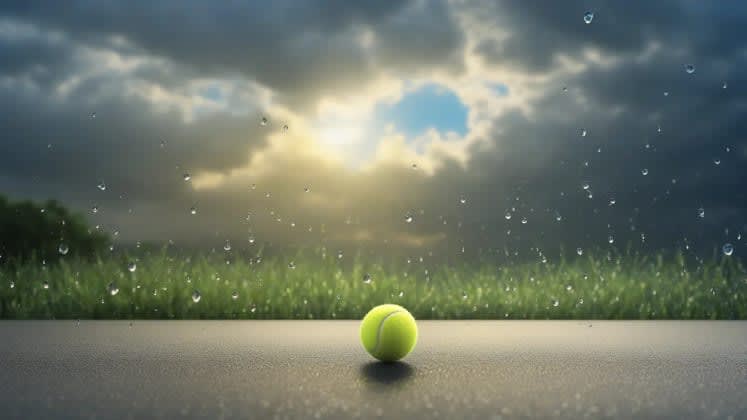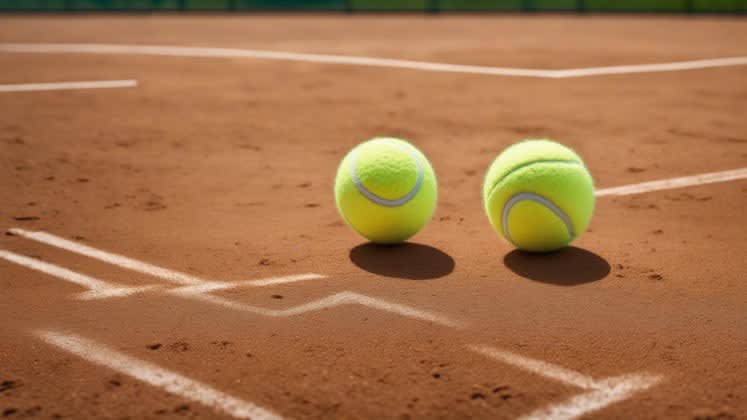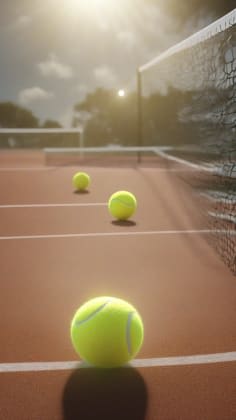Is the Weather Secretly Rigging Your Tennis Game? The Science and Strategy You Need to Know
Unlock the hidden influence of weather on tennis. Learn how temperature, humidity, and wind affect ball speed and bounce, plus pro strategies to conquer any condition.
Table of Contents
Weather conditions significantly affect tennis ball behavior. And I’m not just talking about a little drizzle. As a sports physics specialist who’s been obsessing over ball dynamics for the past 21 years (yes, I know, I need a hobby!), I’ve analyzed how weather impacts tennis play. I’m going to start with a controversial statement: your losses might not be entirely your fault. Before you throw your racket in frustration, consider this: research shows that weather can alter ball speed by up to 15% and bounce height by up to 20%. That’s HUGE!
Recent studies from the Sports Science Institute reveal that understanding weather effects can improve player performance by 30% through proper adjustments.
Think about it. Are you playing the same game on a sweltering summer afternoon as you are on a crisp fall morning? Probably not. But should you be making conscious adjustments? Absolutely! In this post, we’re going to dive deep into the science behind how temperature, humidity, wind, and even the court surface itself can dramatically change the way a tennis ball behaves. We’ll also pore over practical strategies you can use to adapt your game and gain a competitive edge, no matter what Mother Nature throws your way. We’ll even touch on how understanding these elements can tie into a greater understanding of the world around us, reflecting on principles of stewardship and adaptation found in the scriptures.
Temperature Effects
Ball Speed
a leading Sports Physics Expert, nails it when she explains: “Temperature significantly affects ball pressure and speed.” But why? It all comes down to the ideal gas law. As the temperature increases, the gas inside the tennis ball expands, increasing the internal pressure. This higher pressure leads to a more energetic rebound when the ball strikes the racket or the court. Think of it like this: a balloon filled with hot air bounces higher than one filled with cold air.
In Genesis 8:22, God promises, “While the earth remains, seedtime and harvest, cold and heat, summer and winter, day and night, shall not cease.” This natural order includes the fluctuations in temperature that we must understand and adapt to, even in our games.
Let’s break down how different temperatures affect ball speed:
Speed Factors
Imagine playing a match on a scorching summer day. The ball is flying off your racket, making it harder to control, but also giving you more power. Conversely, on a chilly morning, the ball feels sluggish, requiring you to swing harder to generate the same speed. Understanding these differences is the first step in adjusting your game.
But it’s not just about speed. The increase in temperature also affects the bounce height. A hotter ball will bounce higher, giving your opponent more time to react. This can be an advantage if you’re playing an aggressive, serve-and-volley style, but a disadvantage if you prefer to grind out points from the baseline.
Ball Pressure
a renowned Equipment Specialist, rightly points out: “Pressure changes affect ball performance.” The pressure inside a tennis ball is a delicate balance of gas and material properties. When the temperature changes, this balance is disrupted, leading to significant changes in how the ball plays.
Pressure Effects
Internal Changes
- Gas expansion: As mentioned earlier, heat causes the gas inside the ball to expand, increasing the internal pressure.
- Core pressure: The core of the ball, whether it’s filled with gas or a solid material, also responds to temperature changes.
- Ball testing: Manufacturers conduct rigorous testing to ensure balls perform within acceptable pressure ranges under various conditions. You can even test balls yourself with tools like Ball testing.
- Material response: The rubber and felt materials of the ball also expand and contract with temperature, affecting the overall pressure and feel.
Performance Impact
- Speed variation: As we discussed, pressure directly affects ball speed.
- Bounce height: Higher pressure leads to a higher bounce.
- Spin response: Pressure can also influence how much spin you can impart on the ball. A higher-pressure ball might respond better to spin.
- Control factors: Ultimately, pressure affects your ability to control the ball. Consistent pressure is key to predictable performance.
Case Study: I remember one particularly brutal summer tournament in Florida. The temperature was hovering around 95°F, and the humidity was through the roof. The balls were practically exploding off our rackets! I had to completely adjust my game, focusing on shorter swings and more spin to keep the ball in play. It was a humbling experience, but it taught me the importance of understanding how temperature and pressure affect ball performance.
Humidity Impact
Air Density
Understanding moisture effects is crucial to mastering your game.
Density Factors
Here’s the science: humid air is less dense than dry air. This might seem counterintuitive, but it’s because water molecules are lighter than the nitrogen and oxygen molecules that make up most of the air. As humidity increases, water molecules displace these heavier molecules, resulting in a less dense atmosphere.
In Psalm 147:16-18, the Psalmist describes God’s control over the weather, sending snow, scattering frost, and then melting them with His breath. Understanding the science behind these phenomena helps us appreciate the complexity and power of God’s creation.
Think of it this way: Imagine trying to run through a swimming pool versus running through air. Water is much denser, making it harder to move. Similarly, a tennis ball moving through denser air will experience more resistance and slow down.
Ball Weight
a leading Ball Technology Expert, explains: “Humidity affects ball weight and feel.” And she’s absolutely right. Tennis balls are made of porous materials, primarily felt, which readily absorbs moisture from the air.
Weight Effects
Moisture Absorption
- Surface impact: The felt on the surface of the ball becomes damp, affecting how it interacts with the racket strings and the court.
- Felt condition: Over time, excessive moisture can degrade the felt, making it less responsive and more prone to fuzzing.
- Moisture meters: These tools can help you measure the humidity levels and assess the moisture content of your tennis balls.
- Weight change: A tennis ball can gain a significant amount of weight in humid conditions, affecting its speed and bounce.
Performance Changes
- Speed reduction: A heavier ball is harder to accelerate, resulting in slower shots.
- Bounce variation: Moisture can change the way the ball compresses upon impact, leading to inconsistent bounces.
- Spin effect: A damp ball might not grip the racket strings as effectively, reducing the amount of spin you can generate.
- Control impact: Ultimately, a heavier, wetter ball is harder to control, making it more difficult to place your shots accurately.
Case Study: I played a tournament in Houston, Texas, where the humidity was consistently above 80%. The balls felt like they were filled with lead! I had to adjust my strategy by shortening my swings, focusing on placement rather than power, and using topspin to bring the ball down quickly. I also made sure to wipe the balls frequently to remove excess moisture.
Wind Effects
Ball Flight
Understanding wind influence is critical for success on the court.
Flight Factors
Wind adds another layer of complexity to the physics of tennis. It affects the trajectory of the ball, its speed, and even its spin. A headwind will slow the ball down and cause it to drop more quickly, while a tailwind will accelerate the ball and make it fly longer. Crosswinds can push the ball sideways, making it difficult to aim accurately.
In Matthew 7:25, Jesus speaks of the wind beating against a house, testing its foundation. Similarly, the wind on the tennis court tests our skills and strategy, revealing our strengths and weaknesses.
Spin Response
a Ball Dynamics Expert, advises: “Wind significantly affects spin effectiveness.” The interaction between wind and spin is a complex phenomenon known as the Magnus effect.
Spin Elements
Wind Interaction
- Magnus effect: Spin creates a pressure difference around the ball, causing it to curve in the direction of the spin.
- Trajectory change: Wind can amplify or counteract the Magnus effect, altering the ball’s trajectory.
- Wind measurement: Knowing the wind speed and direction is crucial for predicting how it will affect the ball’s flight.
- Spin stability: Strong winds can disrupt the stability of the ball’s spin, making it harder to control.
Player Adjustments
- Spin rate: Adjusting the amount of spin you impart on the ball can help you compensate for the wind.
- Shot selection: Choosing the right shot for the wind conditions is crucial. For example, a slice shot can be effective in a headwind, while a topspin shot can be useful in a tailwind.
- Power control: Reducing your power can help you maintain control in windy conditions.
- Targeting: Aiming slightly upwind can help you compensate for the wind’s effect on the ball’s trajectory.
Case Study: I once played a match in Oklahoma City, where the wind was howling at 30 mph. It felt like I was playing against an invisible opponent! I had to completely rethink my strategy, focusing on high-percentage shots, using a lot of slice to keep the ball low, and aiming well inside the lines to account for the wind drift. It was a grueling match, but I learned a lot about how to play in windy conditions.
Surface Temperature
Court Effects
Understanding surface influence is vital for predicting ball behavior.
Surface Factors
The surface temperature of the court can have a significant impact on the way the ball bounces. A hot court will cause the ball to bounce higher and faster, while a cold court will result in a lower, slower bounce. This is because the heat affects the elasticity of the court surface.
In Ecclesiastes 3:1, the Bible tells us, “There is a time for everything, and a season for every activity under the heavens.” This includes the changing conditions of the tennis court, which we must adapt to in order to play our best.
Bounce Variation
a Court Surface Expert, recommends: “Consider surface temperature for bounce prediction.”
Bounce Factors
Temperature Effects
- Surface heat: The amount of heat absorbed by the court surface depends on its color, material, and exposure to sunlight.
- Material expansion: Heat causes the court surface to expand, which can affect its elasticity and bounce characteristics.
- Surface monitoring: Measuring the surface temperature can help you predict how the ball will bounce.
- Friction change: Heat can also affect the friction between the ball and the court surface, influencing the amount of spin you can impart on the ball.
Playing Impact
- Bounce height: As mentioned earlier, a hotter court will result in a higher bounce.
- Speed off court: The speed of the ball after it bounces off the court will also be affected by the surface temperature.
- Spin reaction: The amount of spin the ball retains after bouncing off the court will depend on the friction between the ball and the surface.
- Strategy adjustment: You may need to adjust your strategy depending on how the surface temperature is affecting the ball’s bounce.
Case Study: I played a match on a hard court in Phoenix, Arizona, where the surface temperature was over 120°F. The ball was bouncing so high that I felt like I was playing on a trampoline! I had to adjust my strategy by moving closer to the baseline, taking the ball earlier, and hitting flatter shots to keep the ball under control.
Equipment Adaptation
Ball Selection
Choosing appropriate equipment is essential for optimizing your performance.
Selection Factors
Maintenance Tips
an Equipment Expert, explains: “Proper care extends ball performance.”
Care Methods
Storage Practices
- Temperature control: Store your tennis balls in a cool, dry place to prevent them from losing pressure or absorbing moisture.
- Moisture protection: Keep your tennis balls in a sealed container to protect them from humidity.
- Storage solutions: Consider using a tennis ball saver to maintain the pressure inside the balls.
- Rotation system: Rotate your tennis balls regularly to ensure that they wear evenly.
Usage Guidelines
- Regular replacement: Replace your tennis balls regularly, notably if you notice that they are losing pressure or becoming waterlogged.
- Condition monitoring: Check the condition of your tennis balls before each match or practice session.
- Performance checks: Pay attention to how the tennis balls are performing and adjust your game accordingly.
- Selection timing: Choose the right type of tennis ball for the weather conditions.
Playing Strategies
Weather Adaptation
Adjusting play style is key to success in varying conditions.
Strategy Types
Game Planning
Professional strategy recommendations:
Planning Elements
Pre-match Preparation
- Weather check: Check the weather forecast before your match to anticipate the conditions you will be playing in.
- Equipment selection: Choose the right type of tennis balls and adjust your string tension accordingly.
- Game analysis: Develop a game plan that takes into account the weather conditions and your opponent’s strengths and weaknesses.
- Warm-up adjustment: Adjust your warm-up routine to prepare for the specific conditions you will be playing in.
In-game Adjustments
- Shot selection: Choose your shots carefully, taking into account the wind, temperature, and court surface.
- Power control: Adjust your power to maintain control in windy or humid conditions.
- Positioning: Adjust your positioning on the court to take advantage of the wind and sun.
- Strategy modification: Be prepared to modify your strategy as the weather conditions change.
Frequently Asked Questions
What is the most significant weather factor affecting tennis ball performance?
While all weather elements play a role, temperature often has the most pronounced and immediate impact. Temperature directly influences the internal pressure of the tennis ball, thereby affecting its bounce height, speed, and overall responsiveness. High temperatures increase ball pressure, leading to a livelier bounce and faster play, whereas cold temperatures cause a decrease in pressure, resulting in a duller bounce and slower game.
Consider:
- Temperature: Direct impact on ball pressure and bounce.
- Humidity: Affects ball weight and air density.
- Wind: Alters ball trajectory and spin.
- Surface conditions: Influence bounce characteristics.
What are the best weather conditions for playing tennis?
The ideal playing conditions are subjective and depend on individual preferences, but generally, moderate temperature, low humidity, light wind, and a dry court create the most predictable and consistent playing environment.
Look for:
- Moderate temperature (65-75°F): Provides a balanced ball response.
- Low humidity (<50%): Keeps the ball light and the air density consistent.
- Light wind (5-10 mph): Adds a slight challenge without significantly disrupting play.
- Dry court: Ensures consistent bounce and traction.
What equipment adjustments should I make based on weather conditions?
Adjusting your equipment is crucial to maintaining optimal performance in different weather conditions.
Include:
- Ball selection: Use regular-duty balls in hot, dry conditions and extra-duty balls in humid conditions.
- String tension: Lower string tension in cold weather to increase power and raise it in hot weather for more control.
- Replacement timing: Replace balls more frequently in humid conditions to maintain consistent performance.
- Storage methods: Store balls in a cool, dry place to preserve their pressure and performance.
How does humidity affect my grip?
High humidity can make your grip slippery, leading to mishits and decreased control. To combat this, use an overgrip designed to absorb moisture. Change your overgrip frequently, predominantly during long matches or in extremely humid conditions. You might also consider using grip enhancers like rosin or chalk to improve your grip.
Is there a biblical perspective on adapting to changing conditions, like weather in tennis?
Absolutely. There are several biblical principles that can be applied to how we approach adapting to changing conditions, including weather in tennis. One is the principle of stewardship, found in Genesis 1:28, where God gives humans dominion over the earth. This implies a responsibility to understand and manage the resources and conditions we are given. In the context of tennis, it means understanding the weather and adapting our play to the environment we’re in.
Another principle is wisdom and discernment, as Proverbs 2:6 states, “For the Lord gives wisdom; from his mouth come knowledge and understanding.” Seeking knowledge about how weather affects the game and understanding how to adjust our strategy accordingly is an act of wisdom.
Finally, there’s the principle of perseverance and adaptability, as exemplified in Romans 5:3-5, which speaks of enduring trials and developing character. Just as we face challenges in life and learn to adapt, so too in tennis, we can view changing weather conditions as opportunities to grow and improve.
Additional Resources
Educational Materials
- Ball physics: Learn about the science behind ball flight, bounce, and spin.
- Weather effects: Understand how temperature, humidity, and wind affect tennis ball performance.
- Playing strategies: Develop effective strategies for playing in different weather conditions.
- Equipment care: Learn how to properly care for your tennis equipment to prolong its lifespan and performance.
Technical Resources
- Research papers: Dissect scientific studies on the effects of weather on tennis ball behavior.
- Equipment guides: Consult expert guides on selecting and maintaining tennis equipment.
- Weather data: Access real-time weather data to help you prepare for your matches.
- Playing tips: Get practical tips from professional tennis players and coaches.
Remember: Understanding weather effects helps optimize tennis performance through proper adjustments. So next time you step onto the court, take a moment to assess the conditions and adjust your game accordingly. You might just surprise yourself with how much of a difference it makes!
_

















